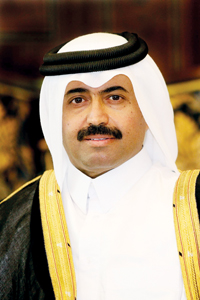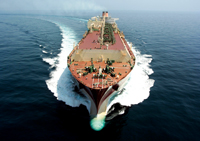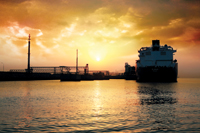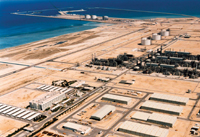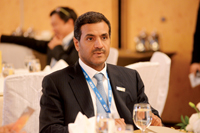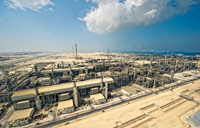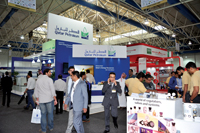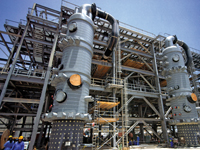
 QP ... focusing on developing petrochemicals
QP ... focusing on developing petrochemicals
QATAR, the world’s biggest liquid natural gas (LNG) exporter, plans to grow its downstream sector with investments over $13 billion.
“Qatar Petroleum has embarked on an ambitious plan to further develop Qatar’s downstream sector, consolidating its position as a major player in the industry. Our long term hydrocarbon development strategy is opening new opportunities for further downstream development, which includes raising Qatar’s petrochemical output to 23 million tonnes per year (mtpy) by 2020,” says Dr Mohamed bin Saleh Al Sada, Minister of Energy and Industry.
“We are investing in mega-expansion schemes that are designed to add further value to our natural hydrocarbon wealth. Such projects include Al Karaana Petrochemical Project, a QP-Shell joint venture. This world-scale steam cracker will mainly produce mono-ethylene glycol, LAO and Oxo alcohol, and is projected to start in 2018.
“Another project to mention is Al Sejeel, a JV between QP and Qapco, which will use ethane, butane and GTL naphtha as feedstock to produce ethylene (1.5 mtpy, high density polyethylene (1 mtpy), linear low density polyethylene (550 thousand tpy), and polypropylene (540 thousand tpy).
Qatar’s downstream development includes the Gasoline and Aromatics project (with a capacity of 1 mtpy of paraxylene, 500,000 tpy of benzene, and 60,000 barrels per day (bpd) of gasoline); the Linear Alkyl Benzene (LAB) Project (with a capacity of 100,000 metric tpy of LAB); and the Butadiene Synthetic Rubber plant (with an approximate capacity of 170,000 tpy of butadiene and rubber derivatives).
The Laffan Condensate Refinery Project Phase 2 (LR2) is one of the important downstream projects in Qatar. The new condensate refinery is similar to the existing LR1 refinery, and has a processing capacity of 146,000 bpd. The additional product capacity will feed other downstream projects, in addition to increasing the quantity of refined products like diesel and jet fuel for the local consumption as well as for exports.”
Qatar has greater petrochemical expansion plans than any other country in the region over the next five to 10 years and is well positioned for success, says KPMG’s global chemicals team.
Paul Harnick, COO of KPMG’s global chemicals practice, based in the US says: “Qatar is taking good steps to continue their success in the petrochemical industry and responding to potential threats from the international marketplace. As US producers are now benefiting from low cost shale gas as a feedstock, it will make the US the cheapest place in the world to manufacture petrochemicals. Over the next five years, the US plans to invest in excess of $100 billion in petrochemical facilities. When this product starts to come on-stream, much of it is likely to flow into the Asian market – putting it in direct competition with the product from the Middle East.”
 |
Dr Al Sada ... Qatar is well placed to meet |
Mike Shannon, global head of KPMG’s chemicals practice says: “Petrochemical companies in Qatar have some really big decisions ahead of them. They are facing the choice of defending their markets in Asia against the low cost US product – with a potential impact on price and margin. Or, do they change their strategy and look to expand into Europe, where they will still have a significant price advantage but will have to reinvent supply chains and establish new customer relationships? One alternative strategy, which many Middle Eastern chemical producers have considered, but not yet conquered will be to acquire or develop technology to produce more specialised premium products that can then attract higher prices and margins.”
Gopal Balasubramaniam, Qatar-based head (oil and gas) for KPMG in the Middle East, comments: “The real challenge for Qatar and the rest of the Middle East chemical industry is to try to move away from just petrochemical production into some of the more specialty downstream chemical areas where increased margins can be achieved.”
“There are already several interesting developments taking place in Qatar. Firstly, Qatar is planning to set up some SMEs (small and medium enterprises) based on the byproducts produced by the existing petrochemical plants which will further boost the industry here. Secondly, Qatar has started to market petrochemicals through a separate entity, ‘Muntajat’, which aims to improve the prices fetched by the petrochemical companies in the international marketplace,” Balasubramaniam adds.
Meanwhile, Qatar’s natural gas production exceeded 7 trillion cubic feet mark in 2013. This includes 77 million tonnes of LNG exported to more than 25 countries, pipeline gas exports to the UAE and Oman, and domestic consumption, Dr Al Sada says.
Dr Al Sada says Qatar’s prominent position in the global energy market is set to remain for years to come. “The State of Qatar is well placed to meet the increasing demand for gas. We are also committed to continue meeting our obligations as a reliable energy producer, as a partner in development, and as an active player in ensuring market stability.”
Qatar currently has $16.5 billion worth of upstream oil schemes at various pre-execution phases. Given the maturity of Qatar’s oil assets, the planned redevelopment of various offshore fields is set to offer commercial opportunities for oilfield service companies, front-end-engineering-designers (Feed) engineering-procurement-construction (EPC), refining experts, technology providers and downstream marketing executives.
The main government vehicle in the oil and gas industry in Qatar is Qatar Petroleum (QP), which owns all downstream oil interests, negotiates exploration and production (E&P) agreements, has shares in upstream projects and is involved in liquefied natural gas (LNG) projects, and gas-to-liquid (GTL) schemes. It is responsible for about 30 per cent of oil and 50 per cent of gas production.
QP’s integrated business operations provide it a competitive advantage over peers in the market. It has a presence across the energy value chain. The company’s business operations include exploration, development and production; transportation, storage, refining, sales and distribution. In the upstream segment, it has participating interests for high quality crudes and gas in offshore and onshore assets.
 |
RasGas ... contributing significantly to |
The company, through partners, operates seven offshore fields. The oil and gas from the fields are separated through four degassing stations, namely, Khatiyah North, Khatiyah Main, Fahahil Main and Jaleha.
It manages satellite stations at Fahahil North and South, and in Khatiyah South. The company transports total oil from the Diyab satellite station to Jaleha station for processing. It transports stabilized crude oil through a pipeline to Mesaieed port for trade and export. Its terminal and crude oil export operations include supply of crude oil from Idd El Shargi and Al-Karkara fields to Halul storage tanks through subsea pipelines. In the downstream segment, through its wholly-owned subsidiary, Qatar Petroleum Refinery.
QP carries out refining activities starting from the processing of crude oil and condensate into various finished products. Its portfolio of finished products consists of liquefied petroleum gas (LPG), petrochemical naphtha, premium gasoline, super gasoline, jet fuel, diesel and marine fuel oil (MFO).
Diversified business activities support the company in expanding its businesses into different verticals and mitigating business risks. Along with integrated energy operations, the company also carries out various other businesses such as production and sale of fertilisers, steel, aluminium, underwriting insurance, chartering of helicopters and other services.
It operates fertiliser business through Qatar Fertiliser Company (Qafco), with total production capacity of 3.8 mtpy of ammonia and 5.6 mtpa of urea. It is the fourth largest producer of urea and the largest exporter in the world. The company operates an integrated petrochemical plant through Qatar Chemical Co (Q-Chem), a joint venture between QP and Chevron Phillips Chemical Company, with production capacity of 36,000 mtpy of sulphur, 500,000 mtpy of ethylene, 453,000 mtpy of high density polyethylenes (HDPE) and 47,000 mtpy of 1-Hexene. It produces methanol and methyl tertiary butyl ether (MTBE) through a joint venture, Qatar Fuel Additives Co. (Qafac), with production capacity of 983,330 tpa of methanol and 610,000 tpy of MTBE. Through Qatar Vinyl Co (QVC), it produces intermediates in the PVC industry.
QVC has a production capacity of 730,000 mtpy of caustic soda liquid, which is used in the manufacture of paper, soap, and detergents and has industrial applications. It carries out the production of heavy-duty plastic bags, sheets and other plastic products through Qatar Plastic Products Co (QPPC), for industrial purposes from polyethylene produced in Qatar.
The company operates steel business through Qatar Steel Company (QSC). QSC has two bar mills at Mesaieed, Doha and a bar mill in Dubai, with production capacity of 300 KMT.
It produces lubricants through a subsidiary, Qatar Lubricants Co (Qalco), which caters to the demand in local market and exports the excess to Saudi Arabia, Bahrain and Yemen. The company provides ship repair and marine services through Qatar National Navigation & Transport Co (QNNTC); and construction services for offshore and onshore industry through Qatar Construction Co (QCON). It conducts aluminium business through Qatar Aluminium (Qatalum), a joint venture between QP and the Norwegian company, Norsk Hydro. QP also provides drilling services through Gulf Drilling International (GDI).
The company’s significant asset portfolio strengthens its business operations and enables it to earn higher margins. Its oil and gas fields include the North Gas field, Onshore Oil, and Offshore Oil fields. The company, through its partners, operates seven offshore fields including Al Shaheen by Maersk Oil Qatar; Al Rayyan by Occidental Qatar Energy Company; Al Khalij by Total E&P Qatar Ltd; Idd El Shargi North Dome by Occidental Petroleum Of Qatar Ltd; Idd El Shargi South Dome by Occidental Petroleum Of Qatar Ltd; Al Karkara & A-Structures by Qatar Petroleum Development Company; and El Bunduq by Bunduq Company Ltd. The company has two offshore production stations in the Maydan Mahzam (MM) and Bul Hanine (BH) fields.
Its North Gas field is recognised as the largest single non-associated gas reservoir in the world, with total proven reserves of 900 trillion standard cubic feet (tscf). QP’s onshore fields include Dukhan field with facilities to produce up to 335,000 bpd. The field has around 330 oil producing wells, 57 gas producing wells and 220 water injection wells.
International oil company (IOC) upstream involvement is extensive in Qatar. Foreign groups are active in oil production, gas field development, LNG projects, as well as GTL and petrochemicals schemes.
Among them, Maersk Oil operates the Al Shaheen field in Block 5 and has a PSA for the Block 5 extension area.
Present in Qatar since 1936, Total has a 20 per cent interest in the upstream part of the Qatargas 1, a 10 per cent interest in the Qatargas 1 liquefaction plant JV, a 24.5 per cent stake in Dolphin Energy and a 16.7 per cent stake in Qatargas 2 Train 5 JV.
Total’s Qatari production averaged 139,000 barrels of oil equivalent per day (boepd) in 2012. Total has signed a new agreement with QP under which the two companies will continue to develop the Al Khalij for the next 25 years. The existing exploration and production sharing agreement, signed in 1989, will expire in early 2014.
QP has formally announced a joint venture with private players, led by Total, for the construction of a $1.5 billion condensate refinery at Ras Laffan. At 146,000 bpd, the Ras Laffan 2 (LR2) will double the capacity of the existing Laffan Refinery (LR1) when it comes online in H216. The plant will have a production capacity of 60,000 bpd of naphtha; 53,000 bpd of jet fuel; 24,000 bpd of gas oil; and 9,000 bpd of liquid petroleum gas (LPG). Occidental (Oxy) has expanded the ISND field development programme, which is expected to result in the recovery of approximately 145 million additional gross barrels (bbl) of oil.



































































